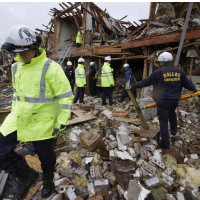No Surprise: Americans Living Near Chemical Industrial Plants are Disproportionally Poor and Minorities
 After the West, Texas, plant expolosion (photo: LM Otero, AP)
After the West, Texas, plant expolosion (photo: LM Otero, AP)
Drive past any chemical plant in the United States and the homes you see near it are likely occupied by poor people and minorities—a reality that has grown for decades.
It is estimated that more than 134 million Americans live within dangerous proximity of more than 3,400 facilities that store or use highly hazardous chemicals, according to a new report, “Who’s in Danger?” by the Environmental Justice and Health Alliance for Chemical Policy Reform.
In addition, millions of others attend school, go to work and perform other routines within so-called chemical “vulnerability zones.” Vulnerability zones are defined as the maximum possible area where people could be harmed by a worst-case release of certain toxic or flammable chemicals. The fenceline zone is one-tenth the distance of a vulnerability zone for a given facility.
African-Americans make up 12.2% of the U.S. population, but are 21.3% of those living in fenceline areas, according to the report. Similarly, Latinos make up 16.1% of the general population, but 25.7% of those in fenceline zones. The numbers are similar for poor people. Those in poverty are 14.3% of the U.S. population at large, but 21.5% of those living in fenceline areas.
Robert Bullard, dean at the Barbara Jordan-Mickey Leland School of Public Affairs at Texas Southern University in Houston frames the issue as more than just having to do with environmental justice and public health. He also considers it a pressing civil rights matter.
“How can it be that since 1987, when the issue was first researched and published in Toxic Wastes and Race, and two decades later in 2007 in Toxic Wastes and Race at Twenty, that people of color today are more, not less, in harm’s way from toxic chemicals and chemical catastrophe 27 years later?” Bullard says in the report.
One startling example of how chemical plants have disproportionately settled around minority communities can be found in Louisiana. Mossville, an unincorporated town founded more than 220 years ago by freed slaves, is today surrounded by 15 “toxic industrial facilities,” according to Dorothy Felix with Mossville Environmental Action Now (MEAN).
“We used to have clean air and water and a healthy quality of life. Now,…we not only live with chronic chemical pollution, but with the fear that at any time, day or night, one or more of those plants could blow up or catch on fire,” she said.
Such a concern happened in the minority-majority city of Richmond, California, where a portion of the Chevron refinery blew up in August 2012, causing 15,000 people to seek medical treatment for respiratory problems.
“All of the various investigations since then, every single one, has concluded that the community is still not safe from the same thing happening all over again. You better believe they would not have built this refinery in the wealthy white communities near by,” Dr. Henry Clark of the West County Toxics Coalition said.
Living so close to refineries and other facilities using harmful chemicals means risking exposure to chlorine, hydrofluoric acid, vinyl acetate, and many other chemicals, according to toxicologist Wilma Subra in Louisiana.
“When a chemical facility explodes or catches fire, some of the most toxic substances made by man can be dispersed into a community, and, depending on the chemical, stay in the air, water, and soil for quite some time,” Subra says.
“Some of these chemicals…are not only immediately harmful to life and health but are linked to respiratory injury, cancer and other chronic health problems,” she adds.
-Noel Brinkerhoff
To Learn More:
New Report Documents Black and Latino Communities at Higher Risk for Chemical Catastrophe (Center for Effective Government)
Who’s in Danger? (Environmental Justice and Health Alliance for Chemical Policy Reform) (pdf)
4.6 Million American Children go to a School within a Mile of a Facility with Hazardous Chemicals (by Noel Brinkerhoff, AllGov)
EPA Allowed Chemical Industry to Control Panel Assessing Cancer Danger in Drinking Water (by Noel Brinkerhoff and Danny Biederman, AllGov)
- Top Stories
- Unusual News
- Where is the Money Going?
- Controversies
- U.S. and the World
- Appointments and Resignations
- Latest News
- Musk and Trump Fire Members of Congress
- Trump Calls for Violent Street Demonstrations Against Himself
- Trump Changes Name of Republican Party
- The 2024 Election By the Numbers
- Bashar al-Assad—The Fall of a Rabid AntiSemite






Comments